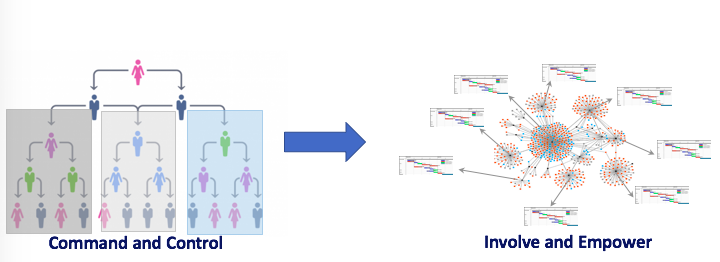
Why are organizations still plagued with all the drawbacks of silos? Because they still adopt a worldview that is out of synch with our times. In order to navigate complexity, organizations must shift from the obsolete, Newtonian worldview of individual, separate and hierarchical parts. What is the direction they need to adopt? Working towards a systemic and interdependent network. This kind of organization is founded on principles of continuous learning, continuous improvement and continuous innovation.
How to build the new organization
How can that be done on a practical level? By combining the approach of the Theory of Constraints with a purely systemic view based on interdependencies and interactions. It does so in practical terms by:
1. building interdependent processes managed through the control of variation;
2. subordinating these interdependencies to a strategically chosen element of the system called “constraint”;
3. designing the organization as a network of interdependent projects with a goal.
The new organization for complexity: coordination not functional reporting
We know that the hierarchical/functional model is inadequate. It creates artificial barriers and does not allow a true understanding of the organization as a series of recurring and non-recurring activities. An organizational structure should therefore be designed to facilitate the orderly management of sets of activities that are continuously created, coordinated, cross-functional, and that evolve in time. There is a precise name for this in English: projects.
A project is exactly this: a network of interdependencies created to achieve in a well- defined time frame a precise goal. A project is a system with a precise duration. A company viewed as a system is therefore a network of projects, and the orderly creation and timely completion of these projects should accomplish the stated goal of the network.
Curing the silo sickness: let’s sum it up
- A functional structure is not suitable to support the systemic approach to managing organizations, and organizations by the nature of their work are cooperative and cross-functional. This is because none of the activities of any company can be performed within the narrow boundaries of a single function;
- Any plausible template for an organizational structure that can foster cooperative work must also take into account the evolution in time of the interdependencies needed to accomplish any activity;
- In essence, the management of any organization becomes the management of a network of recurring, orderly and evolving-in-time activities. We call them projects. The appropriate hierarchy is exercised through ensuring orderly coordination, not functional reporting;
- The backbone of any organizational effort becomes, then, the ability to manage the network of projects any organization is made up of;
- We can safely say that the springboard to overcome the seemingly untouchable functional structure is the idea of a company seen as a network (with a stated goal) of projects.
Principles, methods and tools
It is high time we stop repeating the mistakes of the past and embrace our new reality of complexity. We live in a world that is increasingly a network of networks. We have the science, and thanks to the the contribution of two major management thinkers, Dr. W. Edwards Deming and Dr. Eliyahu Goldratt, we also have the method and the tools. Let’s put them to work.
Watch this TedX video where CEO Corrado De Gasperis explains how he learned from our founder, Dr. Domenico Lepore, to understand that organizations can be managed as systems to achieve dramatic results and envisage a new economics.
Sign up to our blog here and shift your thinking towards broader, systemic possibilities for yourself and your organization. Intelligent Management provides education and training on systemic management, W. Edwards Deming’s management philosophy and the Theory of Constraints (Decalogue methodology) in North America and Europe.
About the Blog Author and Editor
Angela Montgomery Ph.D. is Partner and Co-founder of Intelligent Management and author of the business novel+ website The Human Constraint that has sold in over 20 countries. She is co-author with Dr. Domenico Lepore, founder, and Dr. Giovanni Siepe of ‘Quality, Involvement, Flow: The Systemic Organization’ from CRC Press, New York.





Leave a Reply